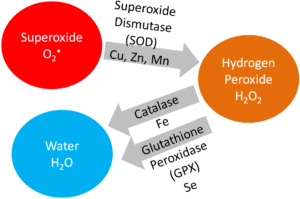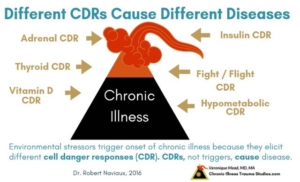The Cell Danger response (CDR), is the body’s natural mechanism to defend and repair itself on the cellular level.
CDR has the molecular function to handle excess free radicals produced when mitochondrial energy production in the form of ATP is compromised. Mitochondria are found in every cell in the body and normally process electrons producing and passing them across five chemical complexes in its “electrical circuitry” called the electron transport chain.

Electrons must arrive at the the final complex to power the production of ATP. This process creates free radicals and also quenches any of their damaging effects via antioxidants called glutathione transferase and reductase, superoxide dismutase and catalase captures the excess electrons during the redox recycling of three cofactors: CoQ10, FAD, a form of vitamin B2, riboflavin, and B3, niacin.
There are certain conditions of the body that will overwhelm the natural balance, the oxidation-reduction balance, or redox for short. Obesity, insulin resistance, glucose intolerance, dyslipidemia, epigenetic factors can result in metabolic disorders that are nearly irreversible. Infection, Antibiotics, psychological trauma, environmental toxins, mycotoxins, can continuously trigger the cell danger response worsening disfunction leading to disease. Chronic intake of high fat and high carbohydrate diet disrupt the gut friendly bacteria favoring intestinal wall damaging gut microbes.
It is important to know this because molecular redox agents work strategically within the methionine, folic acid, and urea cycles and the transsulfation, sulfonation and detoxification pathways as well as the cell cycle, and protein synthesis.

Redox reactions are are governed by changes in pH and temperature but the notation is confusing and difficult to track the reduction and oxidation reactions. Reduction is the gain of electrons or a decrease in oxidation state by a molecule, atom, or ion and designated by subtraction of a plus charge. Oxidation is the opposite. It is important to know this because molecular redox agents work strategically within the methionine, folic acid, and urea cycles and the transsulfation, sulfonation and detoxification pathways as well as the cell cycle, and protein synthesis.
Examples:

* Redox couples for biopterin heme activation are NADPH/NADP+;
* Feedback inhibition of GCLM/GCLC by reduced glutathione;
* Protein synthesis regulation of GSH/GSSG by SAMe;
* Cell membrane protection via the sulfide route to oxidize microbial metabolites with H2S+/SH-, and its regulatory function of the electron transport chain with two other gasotransmitters, N2O-/NO- and CO2-/CO-.
The rate of production or metabolic rate is managed by the thyroid hormone and modulated by Vitamin D and Vitamin A. Electron transport is via the gaining and losing hydrogen ions by a nucleotide called nicotinamide adenine dinucleotide phosphate, the essential vitamin called B3, which in becomes certain forms, an electron carrier as NADP+ and an electron donor as NADPH. A second electron carrier in the redox sequence is FAD and FADH

Irritable Bowl Disease Diabetes, Cancer, Cardiovascular complications, morbid obesity produce redox imbalance leading to the free radicals that produce oxidative stress that can damage mitochondria. Damaged mitochondria can no longer tell damaged cells to self absorb (apoptosis) and order their self destruction, (autophagy). Lingering sick cells influence the immune defenses in negative ways.
Nutrients needed for normal redox processing can be come depleted. Hydrogen sources that can donate and carry electrons are lost. Mineral cofactors like manganese, zinc, copper, heme-iron, molybdenum are consumed Toxins from drugs, or heavy metals can block the redox functions, like mercury, tungsten, aluminum, iron free radicals.

Any lack of vitamin A, D, riboflavin, pyridoxine, thyroxine and triiodothyronine can compromise the protective mechanism of the cell danger response.

Metabolic rate slows down, toxins accumulate, energy is compromised and a resulting vicious cycles leading to chronic illness leading to aging and death by sickness.
There are 4 phases of the Cell Danger Response identified: CDR1, CDR2, CDR3.
CDR1 is the initial inflammatory response that can go from a controlled burn to a wild fire.
CDR2 is the recovery stage of trauma or infection when inflammation is halted and there is an abundance of cellular activity to lay down new cells, replicating massive amounts of mitochondria.
CDR3 is the immune system surveillance is broken and may be misfiring – not resolving new insults, cross-reacting creating friendly fire.
There are checkpoints at every phase transition requiring healthy communication between cells. Cellular activity should resume vegetative functions. If cells are chronically inflamed the communication fails. Cellular activity compromised to either excess cellular production and lack of cellular recognition and destruction (cancer), or disabled cells incapable of waste and nutrient transport and become targets for the body’s immune system (autoimmunity).

Understanding these scenarios helps the practitioner to pinpoint the problem or cluster of problems addressing them in nutritional ways, lifestyle changes and energy enhancement therapies.
Contact us for more information.
https://ArizonaNaturopath.com/contact
